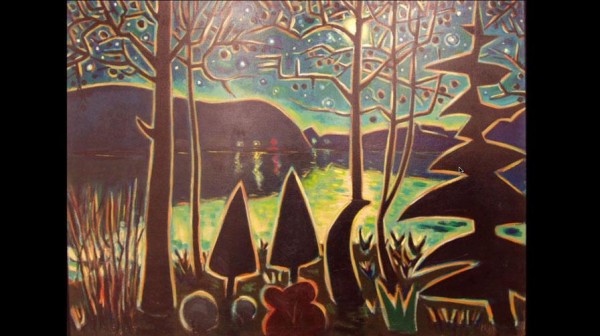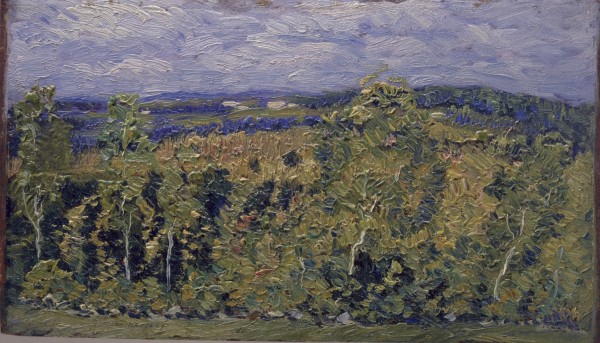Connecting Poetry with Maine Artists
The Thousand Words Project (Symbols and Metaphors), Andrea Bail, Martel Elementary School, 4th grade teacher.
Intro:
Students will consider the components of a Maine landscape and will examine ways artists create a mood or feeling. Students will then create a poem inspired by a landscape painting. Students will share their poem with others.
Common Core State Standards for English Language Arts:
- W.CCR.4 Produce clear and coherent writing in which the development, organization, and style are appropriate to task, purpose, and audience.
- W.CCR.5 Develop and strengthen writing as needed by planning, revising, editing, rewriting, or trying a new approach.
- W.CCR.6 Use technology, including the Internet, to produce and publish writing and to interact and collaborate with others.
- W.CCR.10 Write routinely over extended time frames (time for research, reflection, and revision) and shorter time frames (a single sitting or a day or two) for a range of tasks, purposes, and audiences.
Maine State Learning Standards Visual and Performing Arts:
A. CREATIVE EXPRESSION. Students will create and/or perform to express ideas and feelings. Students communicate through their works, revise and problem-solve, use a variety of processes, and integrate their works with other disciplines.Each art form has specific vocabulary, elements, principles, and structures that allow for communication of ideas, feelings, and moods.
Goals
- Students will demonstrate an understanding of various landforms surrounding Baxter State Park.
- Students will have a better understanding of the hardships Donn Fendler had to endure during his 1939 ordeal in which he was stranded on Mount Katahdin in Baxter State Park for 12 days.
Student Goals
- Students will consider the components of a landscape and will examine ways artists evoke a
mood or feeling through a landscape painting from a Maine landscape and /or Maine artist. - Students will practice composition studies by examining other landscape paintings from
artists from the state of Maine. - Students will select their own landscape and create a poem that demonstrates
understanding of the components of Baxter State Park.
Teach It:
Pre-teaching Activities
- Students will identify specific types of poetry.
- Students will be able to define the specific literary devices used in creating poetry and demonstrate proficiency with them. Define the terms: rhyme, rhythm, repetition, simile, metaphor, personification.
- After a poem is shared, students will answer the following 3 questions:
What do you think is the mood of this poem?
What words did the poet use to create the mood you describe?
What connections to your own life can you make with the mood of this poem?
Key words
Landscape, frontier, wilderness, mountains, Baxter State Park, Mount Katahdin, legend, folk tale, rhyme, rhythm, repetition, simile, metaphor, personification, foreground, middle ground, background, horizon line, hue, tint, feeling, mood, Acrostic Poems, Alphabet Alliteration, Cinquain, Color Poem, Concrete Poem, Creature Alliteration, Five Senses, Haiku, photorealism, modernist, impression, and depiction.
Teaching Activities
- Using their laptop, students will familiarize themselves with images from the Bates College gallery at http://www.thousandwordsproject.org/gallery.shtml to familiarize themselves with various types of Maine landscapes.
- Using the projector, the teacher will share the twelve “All Video Segments” section under quick start on the Home page: http://www.thousandwordsproject.org/index.shtml
Three specific paintings from Maine authors, Joel Babb, Phil Barter, and Marsden Hartley, will be discussed:

Joel Babb
Falls on Nesowadnehunk Stream (Baxter State Park), 1999
oil on paper

Philip Barter
Moonrise, Hancock Point, 1990
oil on canvas

Marsden Hartley (1877-1943, American)
Pallid Spring, 1909
oil on panel
4. Students will select one art piece to use as a visual reference for their poem.
5. Using the types of poems students were previously introduced to, they will decide on what
type of poem they will use to connect with the piece of art.
6. The students will create poems that use sensory description. Students may choose from
syllabic rhythm (meter) and select one literary device such as metaphor, similes,
personification, or repetition.
7. Students will peer edit and teacher edit the rough drafts of their poems.
8. Students will revise and type their poems.
Assessment
Using a rubric, the final poem will be assessed on quality of work and meeting assignment requirements.
| Does Not Meet the Standard | Partially Meets the Standard | Meets the Standard | Exceeds the Standard | |
| Create a poem | 1 | 2 | 3 | 4 |
| Connection to landscape | 1 | 2 | 3 | 4 |
| Sensory description | 1 | 2 | 3 | 4 |
| Conventions | 1 | 2 | 3 | 4 |
Dig Deeper:
Classroom Publication
Poems will be shared with parents during an Authors’ Tea and displayed on hallway bulletin boards.
After you have finished using this TWP lesson with your students, please help us improve the program by responding to this short survey at https://bates.co1.qualtrics.com/SE/?SID=SV_2oikOibUWoOemsl